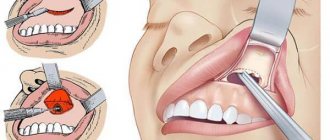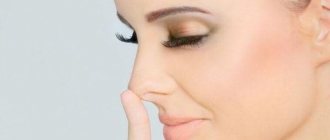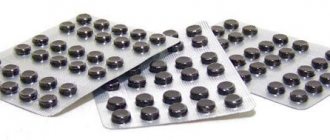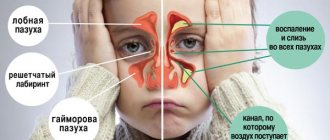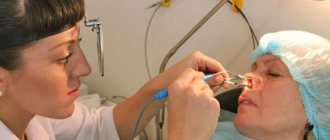Indications and contraindications for surgery
Like any medical procedure, surgery to treat sinusitis has its own indications and contraindications.
Indications include:
- lack of effect from conservative treatment using antibiotics, sprays, anti-inflammatory drugs, physiotherapy techniques;
- the appearance of complications of a secondary type, which are caused by a chronic infectious process in the paranasal sinuses;
- formation of cysts containing infected exudate;
- the appearance of intracranial complications;
- closed sinusitis in chronic form;
- active spread of infection throughout the body;
- the presence of foreign objects in the nasal passages that interfere with normal breathing.
The manipulation also has a number of contraindications. They are determined on an individual basis, and the patient’s general condition is assessed, the presence of diseases of the circulatory, endocrine, and hematopoietic systems, a history of recent surgical interventions, and the presence of active infectious processes in the body. Contraindications can be either temporary or permanent. Many patients cannot decide whether it is worth having surgery for sinusitis at all? The decision regarding the advisability of surgical intervention in a particular case must be made by the attending physician.
Surgical treatment for sinusitis: surgery to clean the maxillary sinuses
Official medicine defines sinusitis as a nosological unit, which is the most common of all types of sinusitis.
To prevent this serious illness, you should know more about the characteristics of the maxillary sinuses, their diagnosis and treatment.
Sinusitis is a typical pathological inflammation of the mucous membrane of the maxillary sinus.
The sinuses act as paired formations, so either unilateral or symmetrical damage to the accessory recesses of the nasal passage may occur.
In addition, sinusitis can affect:
- nasopharynx,
- eye socket,
- bony formations of the facial skull.
This is explained by the fact that the sinuses have common passages and walls.
Treatment of sinusitis
Modern medicine takes a comprehensive approach to the treatment of the typical pathological process of the maxillary sinuses. The following types of therapy are used simultaneously:
- etiological (elimination of the cause),
- symptomatic, which consists of correcting the clinical signs of sinusitis and eliminating pain,
- preventive, for maximum effect of the measures taken.
Such complex treatment can be either conservative (use of pharmacotherapy) or radical (surgery to remove diseased mucosa).
Surgery for sinusitis is necessary in order to restore normal patency of the paranasal sinuses of the upper structures of the respiratory system.
In these cases, they resort to eliminating the following anatomical structures:
- Damaged, inflamed and infected soft tissues,
- Foreign objects that could provoke the development of sinusitis,
- Bone components that are located in the walls of the paranasal sinuses (removal is necessary to create artificial fistulas or widen the passages, which will improve the outflow of inflammatory exudate),
- Cystic or polypous growths of the mucous membrane of the maxillary sinuses.
Treatment using puncture of the maxillary sinus (puncture method)
The nose has paranasal sinuses, which can be punctured not only for diagnostic purposes. In many cases, puncture is indicated as an adequate replacement for complex surgical treatment.
Of course, this method cannot be carried out exclusively locally, without special pharmacotherapy, which necessarily includes broad-spectrum antibiotics. The fact is that nasal sinusitis can be caused by any of a huge number of harmful microorganisms.
The puncture procedure for sinusitis is done using local anesthesia; this is necessary to effectively reduce the discomfort from the manipulation. A person often experiences an acute sensation of a foreign body when passing an otolaryngological needle through the nose.
The wall of the paranasal sinus is pierced, and the doctor is guided only by tactile experience. The doctor should experience a characteristic “needle drop” sensation, which also occurs during a spinal cord biopsy.
Aspiration equipment removes the inflammatory exudate, then the maxillary sinuses are washed with a mixture of antibiotics.
Endoscopic surgery
Endoscopic (or intranasal) surgery for sinusitis is a minimally invasive surgical procedure. After the operation, there are no visible permanent scars or serious disruption of the natural structure of the upper respiratory tract.
Also, after such a surgical intervention, according to statistics, complications appear much less often than with traditional surgery. In addition, the endoscopic procedure is cheaper than conventional surgery, making it accessible to most patients.
Endoscopic surgery lasts from 30 to 90 minutes. The time of the procedure depends on the individual characteristics of the person and his anatomical structure of the paranasal sinuses. The experience of the surgeon is also important.
This surgical intervention can be performed both in inpatient and outpatient settings, that is, in a clinic.
At the beginning of the procedure, an endoscope, which is a special optical device, is placed into the nasal cavity. Using an endoscope, the doctor sees what is happening in the cavity. The device can have a photo or video function, which allows you to use the information obtained as educational methodological material.
When the diagnosis is confirmed visually, surgical instruments are introduced into the nasal cavity. Typically, this is one of the following devices:
- tissue burning laser,
- scalpel,
- hangnails, which are needed to eliminate growths.
Surgical treatment of sinusitis is not painful, so doctors do not administer anesthesia. If the patient’s body is highly sensitive, a decision may be made to use local anesthesia.
To make sure that endoscopic surgery is painless, and to study all the intricacies of the work of otolaryngologists, resources with photos and videos are available, where you can see a detailed performance of this surgical procedure.
Traditional surgery
Sinusitis is a complex pathological process that can provoke a large number of serious complications. The disease is characterized by a change in its course, location and stage.
If treatment with pharmacological agents does not help, and endoscopic surgery also does not bring results, then a method is used that consists of opening the source of inflammation and removing damaged tissue.
For the duration of treatment, which involves surgery, the patient is admitted to a hospital. A special diet is prescribed that corrects the general condition and reduces the development of clinical symptoms. On the day of surgery, the patient should not eat or drink.
The first step in surgical intervention is to open access to the maxillary paranasal sinuses. Depending on the location of the sinusitis, there are two methods for opening access to the additional pocket:
- oral (through the oral cavity),
- through the skin of the face.
There are many photos and videos available online that show how each cut is made.
In recent years, the first surgical access has become increasingly popular, since it is subsequently less noticeable to others. The postoperative scar is almost impossible to see even upon closer examination. It should be noted that the operation is usually performed under anesthesia.
The pathological contents of diseased sinuses are removed using a special otolaryngological instrument. Outwardly, it resembles an ordinary spoon.
Since the operation is performed under anesthesia, the doctor’s actions do not cause any discomfort in the person. The sinus is completely open for examination by a doctor, and this significantly reduces the risk of polyps or secondary sinusitis. Among other things, additional pockets of the respiratory system may be examined.
In the period after surgery, gauze bandages are used to absorb physiological secretions and blood.
In addition, doctors advise adhering to a specific diet to increase the body’s reparative abilities. The diet promotes an accelerated healing process, so the scar forms faster and has a denser structure.
In parallel, antibacterial pharmacotherapy can be carried out, which includes a number of additional preventive actions, and Elena Malysheva will talk about this in detail in the video in this article.
stopgripp.ru>
Puncture
Puncture or, as it is also called, puncture is one of the classic operations performed for sinusitis. It is often regarded by doctors as a therapeutic and diagnostic procedure, since during its implementation it is possible to obtain material for bacteriological research and the choice of further treatment tactics. Read more about punctures for sinusitis→
The intervention is performed under local anesthesia or general anesthesia, depending on the general condition of the patient and the presence of additional diseases. In most cases, local anesthesia is preferred. During the procedure, the doctor makes a puncture in the maxillary sinus and removes purulent contents.
Basically, the operation bears fruit after the first time, but sometimes it needs to be repeated. If after 5-6 manipulations relapses of sinusitis still develop, they resort to more serious methods of solving the problem.
After the suction instrument is removed from the sinus, it must be rinsed. The Furacilin solution is mainly used, with which you can neutralize a significant part of pathogenic microorganisms and significantly reduce the risk of relapse.
Types of operations
At this point in time, three main methods of surgical treatment of sinusitis are used:
- puncture;
- sinus cleansing by endoscopy;
- traditional operation.
Preference for one or another method of surgery is given in accordance with the degree of damage to the maxillary sinuses.
Puncture
In this case, there is no need for any special preparation. In the adult population, the operation is performed under local anesthesia. In children - under general anesthesia.
The process of the surgical procedure is as follows:
- A swab soaked in an anesthetic is used to numb the nasal cavity.
- After tissue sensitivity disappears, a thin needle is inserted into the nasal canal, located below or in the middle, which pierces the maxillary cavity.
- Using a syringe, all existing contents of the sinuses are sucked out.
- Finally, the nasal sinuses are rinsed using a catheter.
Since the internal nasal cavities must be washed every day, the catheter is left inside to avoid injury to the mucous membranes. Sodium salts, saline, and iodinol are suitable as irrigating solutions. Antibacterial drugs are prescribed in combination. The occurrence of complications in the form of otitis media, swelling of the cheek and others is possible only in the case of an incorrect puncture.
Endoscopic sinus cleansing
This type of surgical intervention is a gentle type. During the operation, a special device is used, an endoscope, equipped with a microscopic camera, which allows the nasal cavity to be freed from the most minor tumors. As a rule, the endoscopy method is used to remove growths, polyps, and cysts in the nose.
The essence of the operation is the introduction of a special device into the nasal cavity, which, depending on the type of sinusitis, can be equipped with different attachments. For example, small rotating nozzles are used to scrape soft tissue.
Upon completion of the surgical process, the nose is bandaged, and the patient must continue to visit the doctor for some time to remove dry blood crusts and discharge. It is also necessary to take antibiotics, as well as use drops.
Traditional operation
This method is used in extreme cases, in which infection of the brain and cranial tissue is observed. The operation is performed through the bone tissue of the upper jaw from the front side or from the oral cavity:
- An incision is made into the bone.
- The tissue parts that stop the removal of mucus from the sinuses are removed.
In this case, at the end of the operation, a bandage is also applied to the nose, which will absorb postoperative discharge. In order to moisturize the nasal cavity, saline solutions are instilled.
Balloon sinuplasty
A technique that has recently become actively used for sinusitis. The principle of the intervention is very simple: it is necessary to expand the sinuses of the nasal cavity, which are in a narrowed state due to illness.
The doctor, using special flexible conductors that prevent trauma to the nasal cavities, inserts special balloons into the sinuses. When the balloon is in the right place, it is inflated with air using a cuff, which allows you to expand the diameter of the anastomosis and eliminate pus and accumulation of microorganisms by rinsing. After dilation of the sinuses, it is also possible to increase aeration, which has a positive effect on the healing process.
The intervention has become especially popular due to the absence of trauma to the natural structures of the nose, as well as the almost complete absence of complications.
Catheter Yamik
Another minimally invasive method that helps with sinusitis. The device consists of three tubes of different lengths, two of which have special cuffs. The catheter is inserted through the nasal passages, the cuffs are inflated, creating a slight vacuum, thanks to which accumulations of pus can be easily removed from the sinus affected by the disease. To facilitate the insertion of the catheter and reduce swelling, the mucous membranes can be treated with a vasoconstrictor and an antiseptic. After removing the pus, the sinuses must be washed.
The operation itself is so simple that it can be performed even in a clinic. There is no need for anesthesia, since the intervention is completely painless.
Endoscopic surgery
Unlike previous methods, endoscopic intervention for sinusitis is considered a radical way to solve the problem, even despite its low invasiveness. It is mainly resorted to if previous treatment methods have proven ineffective. To carry out the intervention, it is necessary to use an endoscope, so it is impossible to perform it in an outpatient setting.
A device equipped with a camera allows you to monitor the progress of the intervention from the inside. Thanks to this, it is possible to preserve the maximum amount of healthy tissue and cope with pathological changes. In this case, the doctor will clearly understand what he is doing, not acting blindly. During an endoscopic operation, usually not only the pus is sucked out from the sinuses, but also the overgrown epithelium, which is no longer able to fully perform its main functions, is removed.
Laser
Laser therapy for sinusitis is a type of endoscopic intervention. Laser exposure refers to the effect on the mucous membranes of specially focused light rays of a certain frequency and high intensity. During irradiation, a microburn of the nasal mucous membranes appears, which allows the destruction of pathogenic microorganisms that led to the development of sinusitis.
It is important to understand that the intensity of the burn during laser treatment is so low that the patient does not feel anything at all. In most cases, strong anesthetics are only used if the patient is very sensitive to pain.
Such an intervention has several advantages:
- several successive sessions of laser treatment can reduce the thickness of the mucous layer, which improves the aeration of the nasal sinuses and reduces the rate of reproduction of pathogenic microorganisms in them;
- thanks to external influences, it is possible to improve blood circulation processes and, as a result, regeneration;
- due to the presence of a foreign object, local immunity is activated, which also contributes to the destruction of pathogenic microorganisms.
Caldwell-Luke operation
The Caldwell-Luc operation, used for severe sinusitis, is the most radical of all types of interventions. It is carried out only if the disease has affected the mucous membranes of the sinuses so severely that other treatment methods have been ineffective. Such changes occur most often with odontogenic, cystic or fungal sinusitis.
The manipulation is performed under general anesthesia. The patient is in a supine position. The doctor, moving the upper lip, makes an incision under it on the side on which the diseased sinus is located. Then, using a chisel or drill, the doctor is able to examine the maxillary sinus through the bone tissue and removes pus and pathologically altered mucous membrane from it. The intervention is considered the most traumatic and complications are usually associated with it, ranging from intolerance to anesthesia and ending with purulent inflammation of the postoperative wound.
When is surgery needed for sinusitis?
As already mentioned, not every patient with inflammation in the maxillary sinuses needs surgical treatment. Let us list the main indications for surgical interventions.
- Accumulation of pus in the sinus cavity. In this case, most often, artificial removal of pus is necessary in the case of complete closure of the sinus - that is, blockage of the sinus excretory duct into the nasal cavity. Pus, accumulating in a closed bone cavity, puts pressure on its walls and leads to unbearable headaches. With a further increase in the volume of pus, it may break out under pressure into neighboring structures: the upper jaw, palate, orbit, meninges.
- The presence of chronic sinusitis with frequent exacerbations and a long course. To begin with, it is important to understand that a closed sinus cavity with a tiny excretory duct is very predisposing to the development of chronic inflammation. Therefore, chronic sinusitis is a fairly common pathology of the ENT organs. During constant, sluggish inflammation, various abnormal “plus tissues” are formed in the sinus mucosa - polyps, adhesions, cystic cavities. These formations, in turn, contribute to the further development and course of chronic inflammation, often further blocking the exit from the sinus. It turns out to be such a vicious vicious circle .
- The presence of abnormal formations in the sinus cavity - both congenital and acquired. Congenital formations include pathological bony sinus septa, various tumors and cysts, bony protrusions and ridges that prevent adequate ventilation and outflow from the sinus. Acquired ones include the structures listed in the previous paragraph, as well as various foreign bodies. Such foreign inclusions in the maxillary sinus are the smallest toys or their parts, which the child thrust deep into the nose and, when inhaling, are drawn into the sinus cavity. Fortunately, these are extremely rare cases. Most often one can observe fragments of dental filling material, bone fragments of teeth or dental devices that have fallen into the sinus cavity during the treatment of molars of the upper jaw. Such foreign bodies cause chronic inflammation in the sinus.
Postoperative care
The specificity of most operations performed for sinusitis is such that very little external damage is caused to the body. Thanks to this, postoperative care for the patient is minimized and does not present any difficulties.
A person who has undergone surgery to remove sinusitis is allowed to go home a few hours after the end of the procedure. Rarely, if unforeseen complications develop, you have to stay in the hospital for a longer period.
After discharge, the patient is prescribed the same medications that were used during the main treatment of sinusitis.
These include:
- broad-spectrum antibiotics (penicillins, macrolides, cephalosporins, fluoroquinolones);
- vasoconstrictor medications (Oxymetazoline, Naphazoline, Xylometazoline);
- antihistamines (Zodac, Zyrtec);
- local glucocorticosteroids (Nasonex).
Sinusitis is a disease that often requires surgery if conservative treatment methods are ineffective. The decision about which intervention technique is suitable for a particular patient is best left to the doctor. Only a specialist will be able to determine the presence of indications and contraindications for surgery based on the individual characteristics of the patient and the stage of the disease. It is not recommended to refuse surgical intervention if the doctor raises the question of its necessity.
Author: Arina Volkova, doctor, especially for Moylor.ru
Sinus puncture
In addition to surgical treatment by maxillary sinus or endoscopic surgery, puncture of the maxillary sinus, called puncture, is widely used. It can be prescribed for both therapeutic and diagnostic purposes, and is a very effective method of treating pathology. A puncture can effectively treat purulent sinusitis if performed correctly.
The manipulation is done under local anesthesia. In addition to eliminating the contents of the cavity, it is washed and irrigated with antibacterial and antiseptic solutions. After the puncture, a course of antibacterial therapy with drugs that have a wide spectrum of action is prescribed. This is due to the fact that pathology can develop due to the introduction of various microorganisms.
Local anesthesia is done by introducing a turunda with an anesthetic into the nasal passage. It allows you to eliminate pain and discomfort. Sometimes a sensation of a foreign body in the nose may develop during the procedure. It should be noted that the doctor relies solely on his tactile sensations and experience during manipulation, and his incorrect actions can lead to undesirable consequences.
An ordinary syringe can be used as equipment to remove the contents of the sinus. They also inject antibacterial agents and antiseptic solutions into the maxillary sinus.
